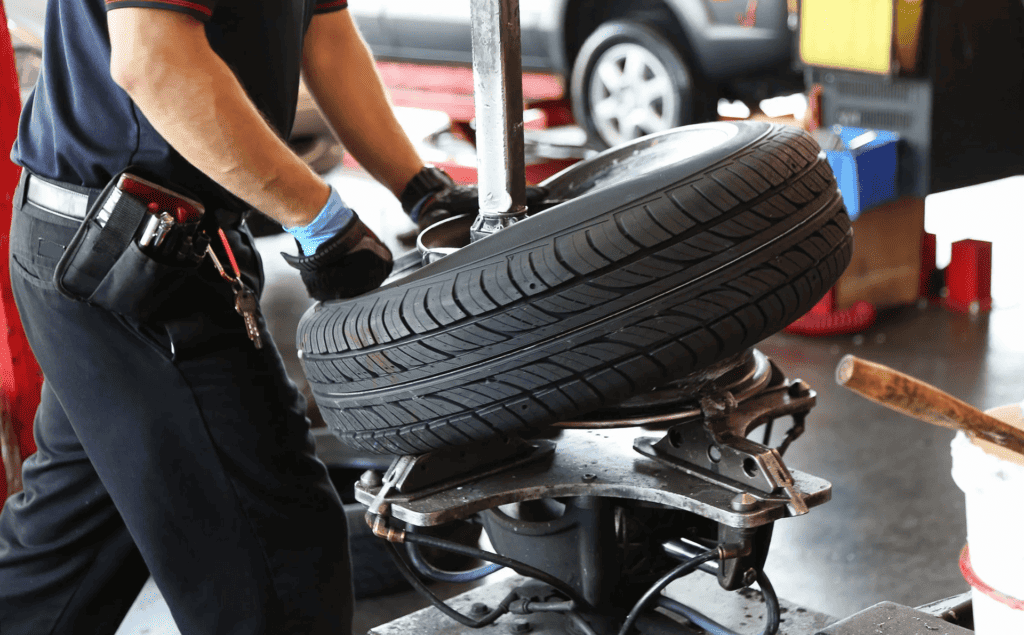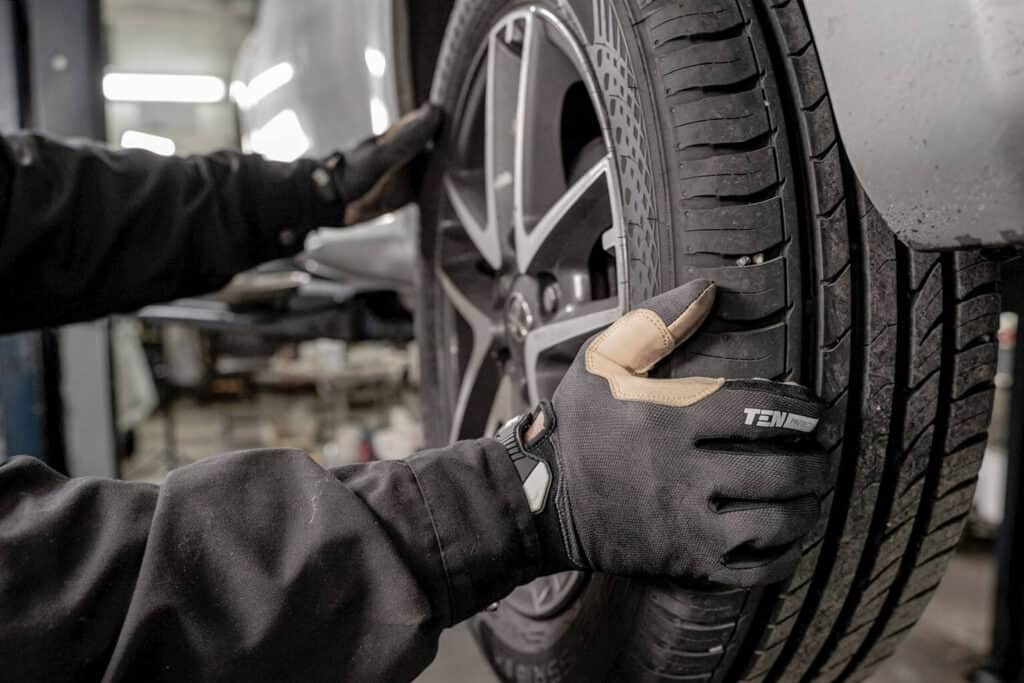What is an On-Rim Tire Change and Replacement?
Just like switching shoes before a dance, an on-rim tire change and replacement involves swapping out your old, worn-out tires with fresh ones, all while keeping the original rims in place. It’s an important process to ensure your vehicle is wearing the right ‘shoes’ for its many dances on the road.
How Much Will it Cost to Get an On-Rim Tire Change and Replacement in Canada?
Just as the cost of a pair of shoes can vary, so too can the cost of on-rim tire changes and replacements. The average cost in Canada can range from $70 to $125 per tire, including labor, which typically takes around 30 to 60 minutes. However, the total cost can vary based on the type of tire, vehicle model, and labor rates. So, the final bill might feel like an unexpected surprise at a party!

When Should I Consider an On-Rim Tire Change and Replacement?
You should consider an on-rim tire change and replacement when your tires start showing signs of aging like:
• Worn Down to the Minimum Tread Depth: Tread depth is like the icing on a donut, you need it there for the full experience. In Canada, the minimum legal tread depth is 1.6mm. Once your tires are worn down to this point, it’s time for a change.
• Changes in Vehicle’s Handling or Ride Comfort: If your ride feels more like a wooden roller coaster than a smooth sail, it could be a sign your tires are worn out. Changes in handling or comfort can signal tire issues.
• Visible Damage: Tires can develop visible damage over time, like cuts, cracks, or bulges. It’s like having a tear in your favorite pair of jeans, only much more dangerous.
• Age of the Tires: Like an overripe banana, tires too have a shelf life. Even if they look okay and have plenty of tread depth left, tires should generally be replaced every six years, regardless of use. It’s their retirement age, let’s say.
How Long Do Tires Typically Last before Needing Replacement?
Much like your favourite pair of sneakers, tires can’t last forever. On average, tires should be replaced every 5 to 6 years, but the actual lifespan can vary based on usage, driving conditions, tire type, and maintenance.
What are the Signs that Indicate I Need to Replace My Tires?
Your tires will be crying out for retirement with clear signs such as:
1. Uneven or Rapid Tread Wear: It’s like walking with one shoe heel worn down more than the other, not the best feeling! Uneven wear could indicate alignment issues, while rapid wear might mean your tires are under or over-inflated.
2. Frequent Loss of Air Pressure: If your tires are losing air faster than a deflated balloon, they might be damaged or worn out.
3. Vibrations While Driving: Driving should feel smooth, like a boat gently sailing on calm water. If you’re feeling more like a rollercoaster ride, it might be due to your worn-out tires.
4. Visible Damage: It’s all fun and games until someone gets a cut…or crack or bulge. If your tires are showing these signs, they’re calling for a replacement.
5. Age: If your tires are older than the latest Star Wars trilogy, it’s time to consider a replacement. Even if they look okay, tires generally should be replaced every six years.
Remember, your tires are your vehicle’s only point of contact with the road. Keep them in top shape, and they’ll keep you safe.
Can I Perform an On-Rim Tire Change and Replacement Myself?
Attempting to perform an on-rim tire change and replacement yourself might feel like a daring adventure, akin to trying to tame a wild horse with a YouTube tutorial. You may indeed be armed with a wealth of do-it-yourself bravado, but tread with caution. Tackling the tire beast without professional assistance can be risky and time-consuming.
Let’s just say it – changing a tire on the rim is not as straightforward as flipping pancakes. It requires specialized tools, precise technique, and a good chunk of experience under the belt. It’s more like assembling a ship in a bottle while balancing on a unicycle. Sure, it might seem appealing to the adventurous spirit, but the stakes are high. An incorrectly mounted tire can lead to a whole host of issues, from vibration and tire damage to catastrophic tire failure. So, it might be wiser to leave this task to the professionals. After all, no one ever said, “I wish I had made that French pastry myself” when biting into a professionally baked, flaky, buttery croissant.
Is it Safe to Drive with Worn-Out Tires?
“Driving on worn-out tires is like running on a slippery floor with socks on – not a recipe for stability or safety. The treads on your tires are designed for a reason: to provide grip, divert water, and keep your vehicle rolling smoothly and safely. When these treads wear down, your car’s handling is compromised, and the efficiency of your brakes takes a dive. It’s like being at a disco on roller skates – things can get out of control fast. Plus, the thinner your tires get, the greater the risk of damage, punctures, and the dreaded blowout. Imagine cruising down the highway and your tire goes POP! Not a fun situation, to put it mildly.
But the potential hazards don’t stop there. Consider driving during inclement weather – rain, snow, you name it. Tires with sufficient tread depth are like your trusty all-weather armor, offering grip and control when you most need it. Worn-out tires, on the other hand, significantly increase the risk of hydroplaning in the rain or sliding in the snow. Driving on bald tires is akin to trying to ice skate on a hockey rink with sneakers – you’re not going to get the traction you need. So if your tires are looking a bit slick, and not in a good way, it’s high time to consider their replacement. After all, safety should never be gambled with.”

How Can I Extend the Lifespan of My Tires?
If you want your tires to stick around longer than a well-loved pair of jeans, there are a few things you can do:
• Regularly check and maintain proper tire pressure.
• Have your tires rotated every 8,000 to 10,000 km.
• Get regular wheel alignments.
• Avoid driving on damaged roads when possible.
• Do not overload your vehicle.
Can a Mobile Mechanic Perform On-Rim Tire Change and Replacement?
Absolutely! Just like a skilled artist bringing their talents to your doorstep, mobile mechanics like the professionals at Uchanics can bring tire change and replacement services right to your home. They have the tools, expertise, and flexibility to perform on-rim tire changes and replacements wherever your vehicle might be.
Conclusion
The dance of on-rim tire change and replacement is an essential step in vehicle maintenance. Remember, the right ‘shoes’ can make all the difference to your vehicle’s performance and your safety on the road. Don’t hesitate to call on a mobile mechanic from Uchanics when it’s time for the next switch.
Next Steps: Book Your On-Rim Tire Change and Replacement Service
The service most frequently booked by those who read this article is On-Rim Tire Change and Replacement. Uchanics’ expert technicians make the process even more convenient by bringing the service right to your doorstep. We perform this job at your home or office, covering over 40 cities in Ontario, including Oshawa, Ajax, Toronto, Scarborough, Mississauga, Brampton, and more. Our commitment to excellence has earned us more than 700 glowing 5-star reviews. Choose Uchanics for your On-Rim Tire Change and Replacement, and experience unparalleled convenience and top-quality service.
